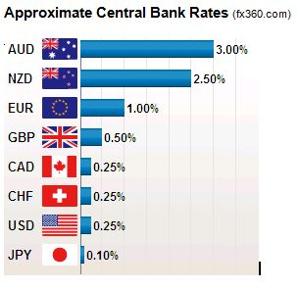Around $3 Trillion in foreign currency (forex) is traded every day, almost 10x the volume of US stocks. A lot of smart people trade forex. Every government, large financial institution, and business that buys or sells overseas trades forex to hedge their investments and production costs, as do hundreds of thousands of private professional speculators worldwide. Thus it's well worth heeding their opinion about the current rally.
As a general rule, when US stock indices rise, the world currency markets feel more optimistic about the world economy, and show higher risk appetite. This in turn increases demand (at least in the short term) for currencies that carry higher risk of depreciating in bad times yet pay higher interest rates on deposits. When US stock indices are dropping, currency traders are often more pessimistic, and flee higher risk currencies into lower risk currencies.
Here's a brief quiz. Look at the table below (click to enlarge) showing central bank rates of the world's major currencies. Which do you think are considered the most risky? Which are considered the safest?
Answer: the Australian dollar is considered the riskiest. The Yen is considered the least risky, with the U.S. dollar considered the next safest. You may agree or disagree, but this IS the prevailing belief in the world currency markets.


Bank financing is the only way the average person is able to buy a home. Due to this, mortgages is very important ... read more
ReplyDeletehttp://www.moneywithhoney.com/mortgagerefinancing